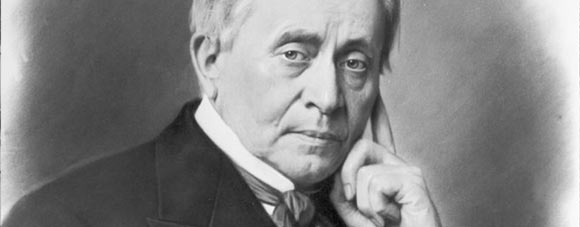Joseph Henry invented “Electromagnetic Induction”
Joseph Henry was a prominent American scientist who is famous for his pioneering work with electricity and electromagnetism. Henry was born in 1797 in Albany, New York. His parents were Scottish immigrants and the family was quite impoverished during most of Henry’s younger years. His father was a laborer who died at a young age, so Henry was sent to live with his grandmother in Galway. He worked at a general store after school and at the age of thirteen, became an apprentice to a silversmith and watchmaker. He was also passionate about the theatre and at one point had almost resolved to become an actor. He joined a local theatre group in which he acted, wrote plays and developed sets.
Henry developed an interest in science at the age of 16, after reading a book called “Popular Lectures on Experimental Philosophy, Astronomy and Chemistry” by G. Gregory. This chance occurrence influenced him so much that in 1819 he decided to enroll at the Albany Academy instead of pursuing a career in theatre. Despite the fact that his tuition was waived, he had to work as a tutor to make ends meet and would often assist his teachers as well. His intention was to pursue medicine, but in 1824 he was appointed as an assistant engineer to survey the construction of a new road between the Hudson River and Lake Erie and his interest was diverted towards engineering. In 1826 he returned to the Albany Academy, this time as a professor of mathematics and physics. The most important research of his career was conducted during this phase of his life.
One of his first successes was improving the electromagnet constructed by William Sturgeon, by tightly coiling insulated wire around a magnet, to make the world’s most powerful electromagnet. The first one he constructed allowed 750 lbs of iron to be lifted using an electromagnet of decent size and cost. His research in the field was also crucial to the development of the telegraph. In 1831, he became the first scientist in the world to use electromagnetism for motion. His research and rudimentary prototype of the motor later led Thomas Davenport to invent the world’s first electric motor. He also discovered the principle of “mutual inductance”, but research of a similar nature was simultaneously being conducted by Michael Faraday in England, and as Faraday was the first to publish his results, he is credited with the discovery of this phenomenon. Henry is, however, solely credited with the discovery of the principle of “self-inductance”.
In 1832, Henry was appointed as a professor at Princeton University (then called College of New Jersey) at an initial salary of $1000 per annum, along with a house and an allowance of $100 for the purchase of new machinery. He enjoyed the intellectual company of his fellow professors, among whom was his brother in law, Stephen Alexander, professor of astronomy. He taught physics, chemistry, geology, mineralogy, astronomy, and architecture at Princeton, and built an even bigger electromagnet that could lift 3500 lbs of weight.
In 1846, the U.S. Congress established the Smithsonian Institution. A distinguished board was formed which chose Henry as the secretary of the newly founded body. He was also one of the original members of the National Academy of Sciences and elected as its second president. Other posts held by him were trustee of Princeton and president of the American Association for the Advancement of Science. Joseph Henry died in 1878 in New York. His funeral was attended by the U.S. president, members of the cabinet, the chief justice of the Supreme Court, members of Congress, and notable scientists and well-known public figures. His statue has been erected outside the Smithsonian building to honor his legacy, and many laboratories and halls at Princeton have been named after him.
